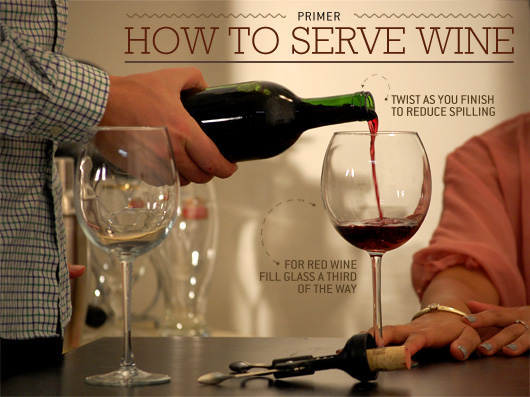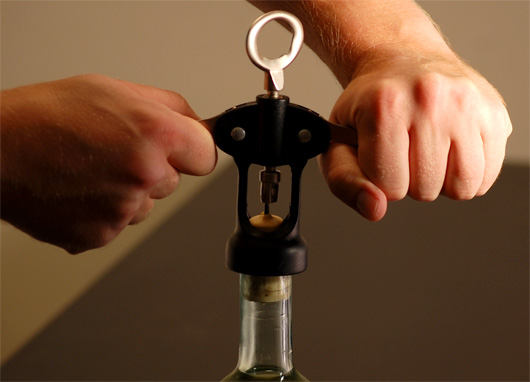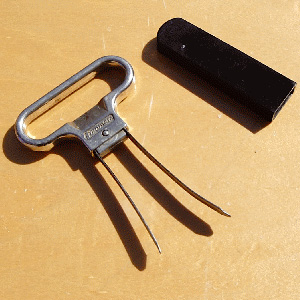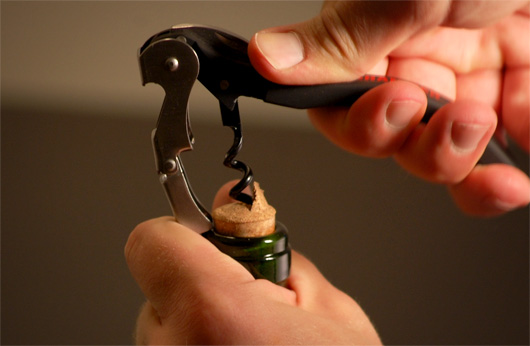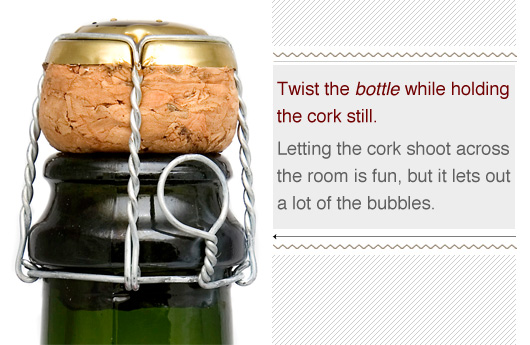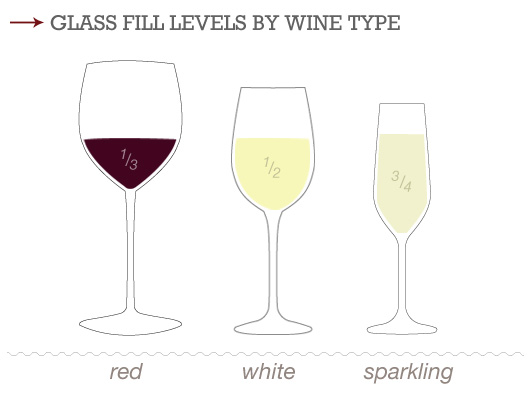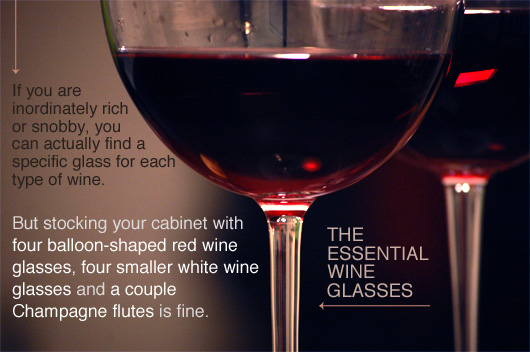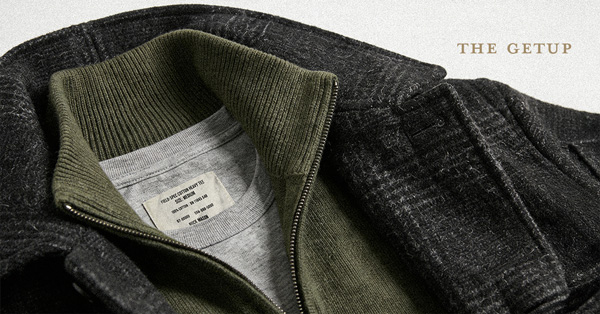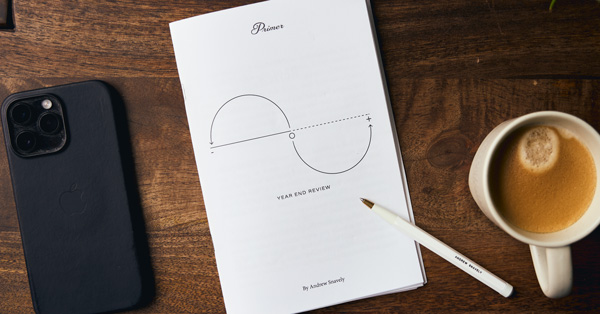Here’s how to serve beer:
“Hey, you want a beer?”
“Sure.”
“Catch.”
“Thanks.”
Wine, on the other hand, carries this daunting air of ritualism that makes many of us feel uncertain when offering it to guests. How should I open the bottle? How cold should it be? What kind of wine should I serve? How much do I put in the glass?
These are all valid questions with somewhat definitive answers. But before I give them to you, I’m going to repeat the mantra of this series on wine: “Relax.”
If you’re pouring someone a glass of wine and they aren’t paying for it, they have absolutely no reason to get huffy about what shape the glass is or what technique you used to open the bottle. If they do, tell them to take a hike. Or blog about it passive aggressively after they leave, whatever.
A Drinking Man's Intro to Wine
But as far as getting the wine flowing, here’s what you need to know:
Opening a Bottle of Wine
Unless you’re a waiter, there’s no wrong way to open a bottle of wine. As long as you get that wine out of the bottle and into your mouth, then it’s a success. The worst thing that can happen is that you get some or all of the cork in the bottle, and even when that happens, it’s not a big deal. Here’s everything you need to know about getting uncorked.
How to Use a Corkscrew
There are a few main types of corkscrew. Whichever one you choose is perfectly fine, as long as you know how to use it properly.
Wing Corkscrew I used to love these as a kid because it looks like a little man doing a jumping jack. This is also the most common type of corkscrew to find in kitchens across America. That’s because it’s pretty much foolproof. It fits squarely over the top of the bottle, allowing you to drill directly into the middle of the cork. (Fun fact: the auger part of a corkscrew is call a “worm”.) Then, you push down on the arms to yank out the cork.
Advantages: Cheap, effective, easy-to-use.
Disadvantages: Bulky and leaves the cork absolutely mangled.
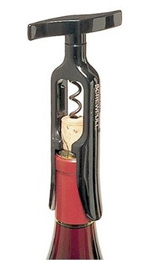
Advantages: Versatile, smaller than a wing corkscrew, a bit gentler on the cork.
Disadvantages: Twice as much twisting, slightly pricier.
Ah So Wine Opener The “Ah So” wine uncorker (aka the “Butler’s Friend”) can’t really be called a corkscrew, since it has no worm. It consists of one long prong and a shorter prong. Slip the prongs in around the cork inside the neck of the bottle, rock it back and forth a bit until the cork works its way up to the top of the prongs and then pull.
Advantages: Your best choice for crumbly or very tight corks. Looks impressive to those who’ve never seen one. Best of all, it leaves the cork intact–great for collectors.
Disadvantages: Small amount of practice required. Not great for looser corks.
Sommelier’s Knife Also known as a waiter’s corkscrew, this is what the pros use. This looks like a pocket knife with an unfolding worm, a lever and a knife. This can take some practice, since you won’t have anything guiding you while drilling the worm in. The key is to get it in straight and smack dab in the center. You can wrap your first around the top of the bottle and use your hand as a guide to increase your odds. Once the worm is in, place the lever on the lip of the bottle and crank it out.
Oh, and if you’re wondering, the knife is for cutting the foil capsule off of the bottle. It may look pretty, but it’s a good idea to do this, since some of these capsules contain lead. Cut it a good half an inch below the lip of the bottle to avoid the wine from spilling over it as you pour.
Advantages: Portable, versatile, makes you look like a pro. Great for removing broken corks (just insert the worm at a 45 degree angle).
Disadvantages: Slight learning curve.
Bonus: How to Open a Screw Top Bottle of Wine 1. Grasp bottle cap firmly. 2. Twist counterclockwise. 3. Enjoy your cheap, yet satisfying wine.
What if I Get Cork in My Wine?
Crumbly corks can often result in flakes or big chunks of cork in your wine. This isn’t a big deal. You can either pick it out with a gizmo called a cork retriever or you can pour it through a paper coffee filter into a decanter. Or, if you feel like it’s the manly thing to do, you can just drink it down, pieces of cork and all. It won’t hurt you.
In a Pinch: Opening a Bottle of Wine without a Corkscrew
Broken wine cork? No problem. Here are a few fun ways to MacGyver a bottle of wine open:
- Man up and power drill that sucker. If it works for the Ace, then it’ll work for you.
- Peel off the foil from the cork. Place the bottle snugly in your shoe, with the base at the bottom of the sole. Hold the shoe and bottle around the back near the heel and whack that thing against a tree or a wall or your nemesis or whatever’s handy. Once the cork is out far enough for you to get a handle on it, wiggle it out slowly.
- Turn a screw into the bottle and leave about half an inch sticking out. Grab it with some pliers or a claw hammer and pull.
- Work a house key into the neck of the bottle, right next to the cork. Keep pushing until the cork falls into the bottle.
Use all of the above methods with caution. Too much force can leave you with broken glass all over the floor and no wine in your belly.
Opening a Champagne Bottle
Did you just win the Super Bowl? Okay, then shake up that bottle of bubbly, fire the cork into the air and spray that expensive stuff all over the locker room. Not interested in wasting wine, soaking your drapes and putting an eye out? Follow these steps:
- Let the bottle rest for a day to let the pressure die down. Or, chill it in a bucket of ice water for 30 minutes. (Be sure to wrap the bottle in a towel afterward, if it’s wet. Otherwise it gets too slippy to handle.)
- Point the bottle away from fragile objects and people you like. Place your hand over the top of the cork and carefully untwist and remove the wire cage.
- Hold the bottle at a 45 degree angle and grasp the cork. Twist the bottle while holding the cork still. As soon as the cork starts moving, push back with some pressure. Let the cork emerge slowly, making it “sigh” instead of pop. Letting the cork shoot across the room is fun, but it lets out a lot of the bubbles.
If the cork is stuck, try running the top of the bottle under some warm water for 60 seconds and try again.
Letting Your Wine Breathe
Some wines taste better after they’ve been allowed to “breathe.” The wine’s been cooped up in that bottle for quite some time, and it needs a little oxygen to soften up the tannins and dissipate any funky bottle odors. The easiest way to do this is to “decant” the wine by pouring it into a wide-mouthed pitcher or decanter. You can also decant it in a wine glass, but it can be hard to resist drinking it.
You don’t have to decant all wines. As a general rule of thumb, you need to decant young, tannic red wines, such as Red Zinfandel, Bordeaux and Cabernet Sauvignon. You should also decant vintage port. White wines very rarely need to be decanted, but if it’s a good bottle of full-bodied dry white wine, it may benefit from some aeration. You should also decant any wine with sediment in the bottle (check it by shining a flash light or candle through the bottom of the bottle).
How long do you need to decant? For most red wines, an hour should do. A vintage port can sit out for six to eight hours and continue to improve.
The most crucial exceptions are old, fragile wines at the peak of their maturity. These will begin to lose their flavor within 10 to 15 minutes of hitting the air. If you’re nervous, just ask if the bottle needs to be decanted before leaving the wine shop.
License to Chill – Which Wines to Serve Cold?
White wine can be served chilled and red wine should be served at room temperature. You’ve probably been following the rule of thumb all your life. But that’s pretty vague advice, considering room temperature where I live can mean 90 degrees or 60 degrees, depending on which half of August it is.
It’s true that tannic red wine gets bitter when cold, but that doesn’t mean serving it warm is a great idea. Red wine is best when it’s about 58 to 60 degrees, which, in real world terms, means popping it into the fridge for 10 to 15 minutes.
White wine, rose wine and inexpensive dry white and dessert wines can be served between 50 and 55 degrees. For finer whites and dessert wines, bump that up to about 58 and 62 degrees. Champagne can get nice and chilly–45 degrees is ideal.
For reference, an optimal household fridge is 40 degrees or cooler inside. So, no matter what kind of wine you’re drinking, you’ll want to let it sit out for a few if it’s been in the fridge all day.
Pouring Wine
You should always pour wine for your guests first. At the restaurants, the waiter will go through this whole ritual of showing you the bottle and letting you sniff the cork before pouring you a tiny little sip. You don’t have to do this at home, since the whole point of this is to see if the bottle has gone bad. If it has, you can just get them a new glass and a new bottle of wine.
As far as which glass to use, it depends on the type of wine you’re serving. For starters, always use clear glass. Tinted or colored glass looks nice, but wine appreciators like to see their wine’s true color. Secondly, use stemware. Holding it by the stem prevents it from getting warm from your hand.
Red wine should be served in a glass with a wide mouth and a capacity of about 16 to 24 ounces. A red wine glass of 12 ounces is fine, too, but bigger is better. Fill it up about a third of the way to leave ample room for swirling.
White wine glasses hold about 10 to 12 ounces. Fill it halfway.
Sparkling wine does best in a flute, which holds 8 to 12 ounces. These narrow glasses help the bubbles last longer. And it looks neat. Fill them three-quarters full. Anyone who swirls a sparkling wine is nuts or drunk.
Those are the basics. If you are inordinately rich or snobby, you can actually find a specific glass for each type of wine. But stocking your cabinet with four balloon-shaped red wine glasses, four smaller white wine glasses and a couple Champagne flutes is fine. You can feasibly use a set of red wine glasses for white wine or vice versa, but if you are drinking two different kinds of wine throughout the night, you'll want a fresh glass for each bottle.
Which Wine for the Occasion?
For dinner, choosing the right wine is as simple as pairing it with the food you’re serving. We covered this a bit in An Explanation of Wine Types, but for truly masterful pairings carefully tailored to your recipe, consult an expert (your local wine shop geek or a Google search). Just tell them what you’re having (and be more specific than “chicken” or “beef”) and ask for some suggestions.
For celebrations, Champagne or another sparkling wine is the obvious choice. A light-bodied white wine like Pinot Gris is a good followup, if you don’t want to pour the expensive stuff all night long.
For kicking it outdoors on a hot summer day, go for a light-bodied low alcohol wine that can be chilled. Rose wines go well for relaxing as well as a picnic.
At any rate, you should progress your wines throughout the occasion from light to bold. Start with something crisp and light-bodied before a meal and then drink red with the meal. Finish off with a dessert wine if you’re feeling fancy.
Last Thoughts
Breaking these rules of thumb won’t wreck your party. Some people enjoy sipping a full-bodied red wine no matter what time of day it is or what’s on the menu. Likewise, others prefer a sweet white wine, even with dinner. Go with what you think your guests will enjoy.
Another quick point of etiquette for gatherings with wine: if someone brings you a bottle of wine, you’re not obligated to serve it, unless you asked them to bring a bottle of wine. Not everyone understands this, though, so you might want to open it along with the bottle you had set aside for the event. Especially if it’s chilled already.
How long does wine stay good after it’s opened? Three days. Or so. Re-cork it and put it in the fridge. Or just finish the bottle when you open it, come on! What is this, church? Quit sipping and kill that bottle. Every day you let that sit, it loses more flavor. So, drink up!



